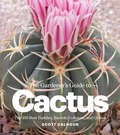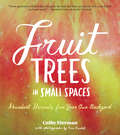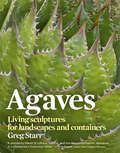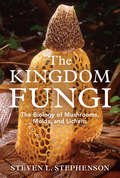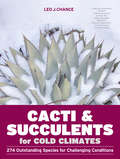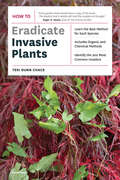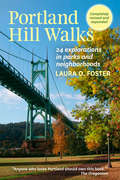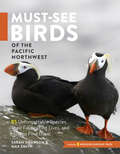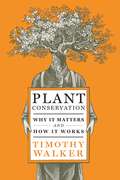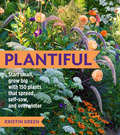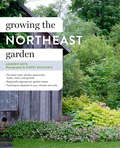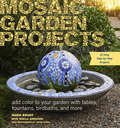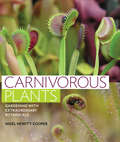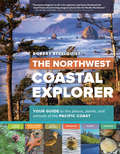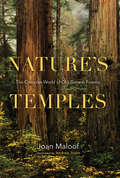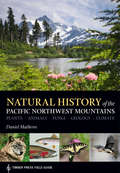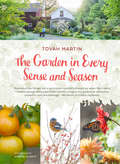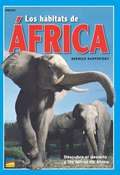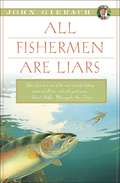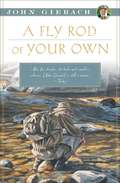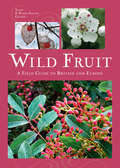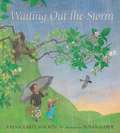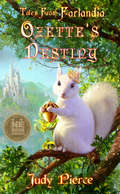- Table View
- List View
The Gardener's Guide to Cactus: The 100 Best Paddles, Barrels, Columns, and Globes
by Scott CalhounWhen it comes to garden plants, cacti are anything but standard issue. The bulk of home gardens contain exactly zero species of cactus, and the thought of growing them makes gardeners think, “Ouch!” In The Gardener’s Guide to Cactus: The 100 Best Paddles, Barrels, Columns, and Globes, Scott Calhoun is out to change that perception, and bring the beauty and ease of cactus home. It’s high time that cacti took their place alongside the trendy succulent.
Fruit Trees in Small Spaces: Abundant Harvests from Your Own Backyard
by Colby EiermanLuscious peaches, crisp apples, and sweet plums right off the tree are hard to beat. For gardeners yearning for the pleasures of home-grown fruit plucked straight from the tree, this deliciously encouraging guide cuts the subject down to size. Colby Eierman, garden designer and fruit expert, shows how trees can easily be tucked into the tiniest spots and still yield a bumper crop of gorgeous fruit. Fruit Trees in Small Spaces covers everything a gardener needs to know about choosing and nurturing the most delicious small-space varieties, including selection, pruning, training, irrigation, and disease prevention. With inspiring ideas for spaces of all shapes and sizes and creative recipes for your incredible harvest, you'll want to plant a mini-orchard in every intimate corner. For the gardener with space limitations, bountiful fruit trees are now within arm's reach.
Agaves: Living Sculptures for Landscapes and Containers
by Greg StarrGardeners and garden designers are having a love affair with agaves. It's easy to see why—they're low maintenance, drought-tolerant, and strikingly sculptural, with an astounding range of form and color. Many species are strikingly variegated, and some have contrasting ornamental spines on the edges of their leaves. Fabulous for container gardening or in-the-ground culture, they combine versatility with easy growability. In Agaves, plant expert Greg Starr profiles 75 species, with additional cultivars and hybrids, best suited to gardens and landscapes. Each plant entry includes a detailed description of the plant, along with its cultural requirements, including hardiness, sun exposure, water needs, soil requirements, and methods of propagation. Agaves can change dramatically as they age and this comprehensive guide includes photos showing each species from youth to maturity—a valuable feature unique to this book.
The Kingdom Fungi: The Biology of Mushrooms, Molds, and Lichens
by Steven L. StephensonThe ubiquitous fungi are little known and vastly underappreciated. Yet, without them we wouldn’t have bread, alcohol, cheese, tofu, or the unique flavors of mushrooms, morels, and truffles. We can’t survive without fungi. The Kingdom Fungi provides a comprehensive look at the biology, structure, and morphological diversity of these necessary organisms. It sheds light on their ecologically important roles in nature, their fascinating relationships with people, plants, and animals, and their practical applications in the manufacture of food, beverages, and pharmaceuticals. The book includes information about “true” fungi, fungus-like creatures (slime molds and water molds), and a group of “composite” organisms (lichens) that are more than just fungi. Particular attention is given to examples of fungi that might be found in the home and encountered in nature. The Kingdom Fungi is a useful introductory text for naturalists, mycologists, and anyone who wants to become more familiar with, and more appreciative of, the fascinating world of fungi.
Cacti and Succulents for Cold Climates: 274 Outstanding Species for Challenging Conditions
by Leo J. ChanceThere are many reasons to grow cacti and other succulents—they're drought-tolerant, low-maintenance, and they look great. But what about hardiness? For those who thought that these spectacular plants were only for gardens in California and the Southwest, guess again—hundreds are fully cold-hardy and can be grown outdoors from New England to British Columbia, Wisconsin to Texas. Cacti and Succulents for Cold Climates is filled with inspirational portraits of 274 plants that can be used to create drought-tolerant gardens, as well as tips from regional experts who have mastered the art of growing cacti in parts of the country not usually associated with high temperatures or a scarcity of water. Expert Leo Chance describes how to prepare planting beds, how to get plants well established, how to handle cacti during planting, how to protect plants from cold winters, and when and how much to water.
How to Eradicate Invasive Plants
by Teri Dunn Chace“Every garden shed should have a copy of this book. The wisdom that it wields will hold the invaders at the gate.” —Roger B. Swain, The Victory GardenHow to Eradicate Invasive Plants offers a clear, practical solution to the increasingly common problem of invasive plants. Clearly written and easy-to-use, Teri Dunn Chance shows you how to recognize more than 200 common invasive plants and offers organic and responsible chemical eradication options for each species. With this reference on their shelves, gardeners, landscapers, and managers of public and private land across the country can confidently tackle the invasive plants to make room for a sustainable plant community!
Portland Hill Walks: 24 Explorations in Parks and Neighborhoods, Completely Revised and Expanded
by Laura O. FosterPortland Hill Walks features twenty-four miniature adventures stocked with stunning views, hidden stairways, leafy byways, urban forests, and places to sit, eat, and soak in the local scene. The revised and updated edition offers five new walks in addition to the well-loved classics, with new contemporary and historical photos and easier-to-follow directions.Whether you feel like meandering through old streetcar neighborhoods or climbing a lava dome, there is a hill walk for every mood. New walks take you up to Willamette Stone State Park, across the St. Johns Bridge, down to the South Waterfront (with a ride on the aerial tram), along a stream in Gresham, and up Mounts Talbert and Scott.Portland is a walking city, and Portland Hill Walks will inspire you to enjoy it to its fullest!
Must-See Birds of the Pacific Northwest: 85 Unforgettable Species, Their Fascinating Lives, and How to Find Them
by Sarah Swanson Max SmithMust-See Birds of the Pacific Northwest is a lively, practical guide that helps readers discover 85 of the region’s most extraordinary birds. Each bird profile includes notes on what they eat, where they migrate from, and where to find them in Washington and Oregon. Profiles also include stunning color photographs of each bird. Birds are grouped by what they are known for or where they are most likely to be found—like beach birds, urban birds, colorful birds, and killer birds. This is an accessible guide for casual birders, weekend warriors, and families looking for an outdoor experience. Eight easy-going birding weekends, including stops in Puget Sound, the Central Washington wine country, and the Klamath Basin, offer wonderful getaway ideas and make this a must-have guide for locals and visitors alike.
Plant Conservation: Why It Matters and How It Works
by Timothy WalkerPlants’ ability to turn sunlight into energy makes them the basis for all life; without them there is no life. And they are more than just a food source—they provide us with fuel, fibers, and pharmaceuticals. Global warming and the destruction of natural habitats are a serious threat to many plants, and there are worldwide efforts to mitigate the disaster. Plant Conservation tackles this essential topic head on. Timothy Walker, as the director of the Oxford Botanical Garden, a leader in the field of plant conservation, plays a key role in this effort. He highlights what is happening now, from cataloging the world’s flora to conservation efforts like protecting plants from overcollecting. He also shows home gardeners how they can become involved, whether by growing their own food to decrease reliance on large agriculture or by making smart plant choices by growing natives and avoiding invasives. Plant Conservation treats a critical topic in an accessible and optimistic way. It is required reading for students, professionals, and anyone with a keen interest in the importance of plants.
Plantiful: Start Small, Grow Big with 150 Plants That Spread, Self-Sow, and Overwinter
by Kristin Green“Thrifty gardeners take note: the bucks saved on plant purchases will pay back the purchase price of Plantiful with dividends.” —Tovah Martin, author of The Unexpected Houseplant Whoever coined the phrase “money doesn’t grow on trees” must not have been a resourceful gardener. Plantiful shows you how to have an easy, gorgeous garden packed with plants by simply making the right choices. Kristen Green highlights plants that help a garden quickly grow by self-sowing and spreading and teaches you how to expand the garden and extend the life of a plant by overwintering. The book features plant profiles for 50 self-sowers (including columbine, milkweed, and foxglove), 50 spreaders (such as clematis, snow poppy, and spearmint), and 50 plants that overwinter (including lemon verbena, begonia, and Chinese hibiscus). Additional gardening tips, design ideas, and inspirational photos will motivate and inspire gardeners of all levels.
Growing the Northeast Garden: Regional Ornamental Gardening (Regional Ornamental Gardening Series)
by Andrew Keys Kerry MichaelsPlant selection and garden style are deeply influenced by where we are gardening. To successfully grow a range of beautiful ornamental plants, every gardener has to know the specifics of the region’s climate, soil, and geography. Gardeners in the northeast are lucky—the regular summer rain, gorgeous summer blooms, and stunning fall color make it an ideal place to garden. But there are drawbacks, like hot and humid summers, bitterly cold winters, and mosquitos. TThe practical and beautiful Growing the Northeast Garden starts with a comprehensive overview of the weather and geography of the area, along with regionally specific advice on zones, microclimates, soil, pests, and maintenance. Profiles of the best trees, shrubs, perennials, annuals, and bulbs offer hundreds of plant suggestions, along with complete information on growth and care.
Mosaic Garden Projects: Add Color to Your Garden with Tables, Fountains, Bird Baths, and More
by Mark Brody Sheila Ashdown“This thorough guide to techniques, tools, and materials is filled with expert tips and tricks. The detailed project instructions will inspire you to make your own mosaicked mark on the landscape.” —Lorene Edwards Forkner, author of Handmade Garden Projects In Mosaic Garden Projects, artist Mark Brody walks step-by-step through the creation of 25 decorative yet functional projects. With simple ideas like address signs and stepping stones to more complex projects such as an orb fountain, Brody also includes with a primer on the fundamentals of mosaic and information on the range of possible materials. Project templates are included along with instructions on how to scale each project. Mosaic Garden Projects is packed with inspiration that will brighten the garden all year long.
Carnivorous Plants: Gardening with Extraordinary Botanicals
by Nigel Hewitt-CooperOnce known only to collectors, adolescent boys, and fans of the cult film The Little Shop of Horrors, carnivorous plants are poised to be the next big trend in home gardening. They provide striking architectural style and can be grown indoors and outdoors. Carnivorous Plants is an accessible, smartly designed guide to growing this unusual group of plants. It offers a general introduction to the world of carnivorous plants, and growing and cultivation information for commonly available and easily grown varieties. Nigel Hewitt-Cooper also provides advice on where to grow the plants; year-round care, cultivation, and maintenance; and a directory of the best carnivorous plants for home gardeners.
The Northwest Coastal Explorer: Your Guide to the Places, Plants, and Animals of the Pacific Coast
by Robert Steelquist“Part field guide, part travel guide, Steelquist writes with the authoritative voice of that friend you want next to you on the trail or in the dunes—the one who knows just where to go for a weekend getaway and what to pack for the Pacific Northwest’s unpredictable weather.” —Portland Monthly Millions of visitors explore the magnificent coastline of the Pacific Northwest and all that it provides—unique plant life, easy-to-find animals, and magical places. The Northwest Coastal Explorer is a fun, engaging, lushly-illustrated guide to the marine life of Oregon, Washington, and British Columbia. Profiles of the flora and fauna include tips on where and how to find them—like the ochre sea stars commonly discovered on exposed rocks and the olive snails found on sandy beaches—while the included getaway guide highlights the best weekend trips for each area.
Nature's Temples: The Complex World of Old-Growth Forests
by Joan Maloof“Maloof eloquently urges us to cherish the wildness of what little old-growth woodlands we have left. . . . Not only are they home to the richest diversity of creatures, but they work hard for humans too.” —New York Times Book Review An old-growth forest is one that has formed naturally over a long period of time with little or no disturbance from humankind. They are increasingly rare and largely misunderstood. In Nature’s Temples, Joan Maloof, the director of the Old-Growth Forest Network, makes a heartfelt and passionate case for their importance. This evocative and accessible narrative defines old-growth and provides a brief history of forests. It offers a rare view into how the life-forms in an ancient, undisturbed forest—including not only its majestic trees but also its insects, plant life, fungi, and mammals—differ from the life-forms in a forest manipulated by humans. What emerges is a portrait of a beautiful, intricate, and fragile ecosystem that now exists only in scattered fragments. Black-and-white illustrations by Andrew Joslin help clarify scientific concepts and capture the beauty of ancient trees.
Natural History of the Pacific Northwest Mountains: Timber Press Field Guide (A Timber Press Field Guide)
by Daniel MathewsNatural History of the Pacific Northwest Mountains is an engagingly written, portable history and identification guide for the flora, fauna, and geology of the region. This guide also includes information about the landscape and weather. Packed with 800 color photographs, this is the perfect overview of the Pacific Northwest if you are looking for a simple way to discover the great outdoors.
The Garden in Every Sense and Season: Gardening to Awaken Your Five Senses
by Tovah Martin Kindra Clineff“Reminds us that the best way to get to know a garden is through our senses.” —Gardenista So much of gardening is focused on the long list of chores—the weeding, planting, and pruning. But what about the joy a garden can provide? In The Garden in Every Sense and Season, Tovah Martin explores the sensory delights in her own garden in 100 evocative essays. Martin shares sage garden advice, offers intimate reflections on her own garden, and urges us to inhale, savor, and become more attuned to our gardens. Packed with lush color photographs, The Garden in Every Sense and Season will help you grow a bounty of gratitude in your own home garden.
WHAT IS MAN?: Adam, Alien or Ape?
by Edgar AndrewsIn 1906, American humorist Mark Twain published a sixty-page essay entitled “What is man?” Consisting of an interminable dialogue between a senior citizen (who believes that man is just a machine) and a young man (who believes nothing in particular but is open to persuasion), it wasn’t one of his finest books. But at least he tried. Authors since then seem to have avoided the subject like the plague, often tackling the respective roles of men and women in society but seldom asking deeper questions about what it means to be human. When the psalmist asked, “What is man?” (Psalm 8 v.4) he was, I think, seeking an altogether more profound answer.Avoidance of the subject is all the more strange because there has never been a time like our own when curiosity about human origins and destiny has been greater, or the answers on offer more hotly disputed. It’s a safe bet that any attempt to give the “big picture” on the origin, nature and specialness of mankind will be contentious —which might explain why writers have generally fought shy of it. Yet at heart it is the question most of us really do want answered, because the answer defines that precious thing we call our identity, both personally and as a race.The Psalmist did, of course, offer his own answer three millennia ago. Man, he claimed, was created by God for a clearly defined purpose — to exercise dominion over planet earth and (by implication) to ultimately share something of the glory of the divine nature. The rest, as they say, is history, but it’s not a happy tale. As Mark Twain says in another essay; “I can’t help being disappointed with Adam and Eve”. Not surprisingly, then, a large proportion of humanity today are looking for alternative solutions, accepting the challenge of the Psalmist’s question without embracing the optimism of his answer.In this book we are going to consider the alternative solutions on offer by considering what it means to be human against the backgrounds of cosmology (man’s place in the universe), biology (man’s place in the animal kingdom), and psychology (man’s consciousness and mind). Finally, we return to the biblical context, arguing that the Psalmist got it right after all.Don’t let the science-sounding stuff put you off. Like its popular prequel, “Who made God? Searching for a theory of everything”, this book is written with a light touch in a reader-friendly and often humorous style. It is intended specifically for the non-expert, with homely verbal illustrations designed to explain and unpack the technicalities for the lay-person. As Dr. Paul Copan (Pledger Family Chair of Philosophy and Ethics, Palm Beach Atlantic University) says, "Edgar Andrews has a way of making the profound accessible. His scholarship informs the reader about key questions of our time, offering wise guidance and illumination."
All Fishermen Are Liars (John Gierach's Fly-fishing Library)
by John Gierach"I have to go fishing; it's my job." John Gierach can say that and mean it. But fishing is only part of his job. The other part is writing about his fishing adventures. And that's the part we readers get to enjoy. In All Fishermen Are Liars, Gierach travels across North America from the Pacific Northwest to the Canadian Maritimes to seek out quintessential fishing experiences. Whether he's fishing a busy stream or a secluded lake amid snow-capped mountains, Gierach insists that fishing is always the answer--even when it's not clear what the question is. All Fishermen Are Liars covers fishing topics large and small: the art of fly-tying and the quest for the perfect steelhead fly; fishing in the Presidential Pools previously fished by the first President George Bush; and the importance of traveling with like-minded companions when caught in a soaking downpour. ("At this point someone is required to say, 'You know, there are people who wouldn't think this is fun.'") Gierach may occasionally lose a fish, but he never loses his passion for fishing or his sense of humor. All Fishermen Are Liars proves yet again that life's most valuable lessons--and some of its best experiences-- can be found while fly-fishing.
A Fly Rod of Your Own (John Gierach's Fly-fishing Library)
by John GierachJohn Gierach, “the voice of the common angler” (The Wall Street Journal) and member of the Fly Fishing Hall of Fame, brings his sharp sense of humor and keen eye for observation to the fishing life and, for that matter, life in general.John Gierach is known for his witty, trenchant observations about fly-fishing. In A Fly Rod of Your Own, Gierach once again takes us into his world and scrutinizes the art of fly-fishing. He travels to remote fishing locations where the airport is not much bigger than a garage and a flight might be held up because a passenger is running late. He sings the praises of the skilled pilots who fly to remote fishing lodges in tricky locations and bad weather. He explains why even the most veteran fisherman seems to muff his cast whenever he’s being filmed or photographed. He describes the all-but-impassable roads that fishermen always seem to encounter at the best fishing spots and why fishermen discuss four-wheel drive vehicles almost as passionately and frequently as they discuss fly rods and flies. And while he’s on that subject, he explains why even the most conscientious fisherman always seems to accumulate more rods and flies than he could ever need. As Gierach says, “fly-fishing is a continuous process that you learn to love for its own sake. Those who fish already get it, and those who don’t couldn’t care less, so don’t waste your breath on someone who doesn’t fish.” From Alaska to the Rockies and across the continent to Maine and the Canadian Maritimes, A Fly Rod of Your Own is an ode to those who fish—and they will get it.
Wild Fruit: A Field Guide to Britain and Europe
by Alain GeneveWild Fruit is a field guide to fruit commonly found in the wild in Britain and Northern Europe. The plant descriptions include information on identification for 220 fruits, and include tasting notes and historical information about the plant’s medicinal uses. Over 400 color photographs show the plants at different points in their maturity, aiding in accurate identification.
Waiting Out the Storm
by JoAnn Early MackenWind whistles in the treetops, thunder rumbles, and lightning flashes and dashes between raindrops. Snug inside, a mother and child listen, watch, and wonder what the animals will do during the storm. Paired with beautiful illustrations evoking the moods and mysteries of the natural world, this lyrical call-and-response text is a lullaby to stormy weather — and to the warmth and safety of home.
Ozette's Destiny: Tales From Farlandia (Tales From Farlandia #1)
by David M. F. Powers Judy Pierce Natalia Nesterova Silvia HoefnagelsAfter being crowned the queen of Farlandia, the white squirrel Ozette finds herself in the midst of a struggle to save the endangered and enchanted forest where she now lives. Can Ozette round up the help she needs to preserve the rhythms of nature that make Farlandia so special? In order to accomplish this gigantic feat, the white squirrel must enter the world of deep, forest magic in an attempt to save her chosen family. But is she ready to learn the truth about the land she loves? She enlists the help of ethereal fairies, elusive elves, and her newest friend Gizmo as they find themselves in a desperate race against Boardmore, Smiley, and time. Under the guidance of Princess Abrianna and the direction of Queen Beatrix, Ozette learns more about her new home than she could have imagined. The secrets that nature holds can only be unlocked when you embark on yet another magical journey with Ozette and her enchanting friends. Are you ready to learn the truth about Farlandia?
Meerkats (Nature's Children Ser.)
by Tim HarrisWhere do meerkats live? What do meerkats eat? How big are meerkats? Find out the answers to these questions and learn all about the physical characteristics, behavior, and habitats of meerkats.
